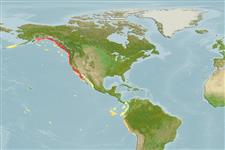Elasmobranquios (tiburones y rayas) (sharks and rays) >
Carcharhiniformes (Ground sharks) >
Pentanchidae (Deepwater catsharks)
Etymology: Apristurus: a-, Latin privative, i.e., without; pristis, from pristes (Gr.), sawyer (but here meaning saw); oura (Gr.), tail, referring to absence of saw-toothed crest of enlarged dermal denticles along upper edge of caudal fin as found in the closely related Pristiurus (=Galeus). (See ETYFish); brunneus: Medieval Latin for brown, referring to its “uniform warm brown” color above and below. (See ETYFish).
More on author: Gilbert.
Environment: milieu / climate zone / depth range / distribution range
Ecología
marino demersal; rango de profundidad 33 - 1306 m (Ref. 96339). Subtropical; 60°N - 39°S, 138°W - 70°W (Ref. 56871)
Eastern Pacific: British Columbia, Canada to northern Baja California, Mexico. Probably south to Panama, Ecuador, and Peru.
Tamaño / Peso / Age
Maturity: Lm ? range ? - ? cm
Max length : 69.0 cm TL macho / no sexado; (Ref. 96339)
Short description
Morfología | Morfometría
Espinas dorsales (total): 0; Radios blandos dorsales (total): 0; Espinas anales 0; Radios blandos anales: 0. Dark brown, with conspicuous light posterior margin on fins (Ref. 247).
Inhabits the outer continental shelf and upper slope (Ref. 244). Found over muddy or sandy bottoms (Ref. 27436). Feeds on small true shrimps, euphausiid shrimps, squids, and small fishes (Ref. 244). Oviparous (Ref. 50449).
Life cycle and mating behavior
Madurez | Reproducción | Puesta | Huevos | Fecundidad | Larva
Oviparous, with a single egg per oviduct (Ref. 244). Eggs are enclosed in oblong transparent cases with tendrils at each end (Ref. 6885). Embryos feed solely on yolk (Ref. 50449). In Canada, females carry egg cases from February to August (Ref. 244).
Compagno, L.J.V., 1984. FAO Species Catalogue. Vol. 4. Sharks of the world. An annotated and illustrated catalogue of shark species known to date. Part 2 - Carcharhiniformes. FAO Fish. Synop. 125(4/2):251-655. Rome: FAO. (Ref. 244)
IUCN Red List Status (Ref. 130435)
Threat to humans
Harmless
Human uses
Pesquerías: sin interés
Más información
Age/SizeCrecimientoLength-weightLength-lengthLength-frequenciesMorfometríaMorfologíaLarvaDinámica larvariaReclutamientoAbundanciaBRUVS
ReferenciasAcuiculturaPerfil de acuiculturaRazasGenéticaElectrophoresesheritabilidadEnfermedadesProcesamientoNutrientsMass conversion
ColaboradoresImágenesStamps, Coins Misc.SonidosCiguateraVelocidadTipo de nataciónSuperficie branquialOtolitosCerebrosVisión
Herramientas
Special reports
Download XML
Fuentes de Internet
Estimates based on models
Preferred temperature (Ref.
123201): 5.6 - 9, mean 6.9 °C (based on 52 cells).
Phylogenetic diversity index (Ref.
82804): PD
50 = 0.5000 [Uniqueness, from 0.5 = low to 2.0 = high].
Bayesian length-weight: a=0.00355 (0.00176 - 0.00714), b=3.09 (2.91 - 3.27), in cm total length, based on LWR estimates for this (Sub)family-body shape (Ref.
93245).
Nivel trófico (Ref.
69278): 3.6 ±0.0 se; based on diet studies.
Resiliencia (Ref.
120179): Muy bajo, población duplicada en un tiempo mínimo superior a 14 años (Fec assumed to be <10).
Fishing Vulnerability (Ref.
59153): Moderate to high vulnerability (48 of 100).
